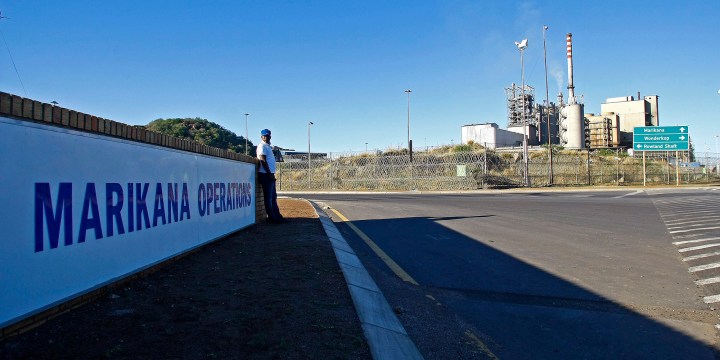BACK FROM THE BRINK
One decade on, the Marikana mine has seen a turnaround in fortunes and is making a punchy profit

Marikana is now a key part of Sibanye’s profitable portfolio. A change of ownership and a surge in prices have pulled the mine back from the brink.
A decade after 34 striking mine workers were shot dead by police in Marikana, the mine that bears its name is making lots of money. Just a few years ago, when it was still a Lonmin asset, its future was in doubt. A change of ownership and a surge in prices have pulled it back from the brink.
Sibanye-Stillwater acquired the Marikana mine in 2019 when it absorbed all of the assets of Lonmin, consigning that company to the scrap heap of history.
Lonmin was in deep trouble at the time. Sibanye CEO Neal Froneman has noted more than once that “it was going to hit the wall” — and it would have taken 30,000 jobs with it. After the massacre, Lonmin struggled for years to remain a going concern.
The five-month strike in 2014 led by the Association of Mineworkers and Construction Union (Amcu) mortally wounded the company. Anglo American Platinum (Amplats) and Impala Platinum (Implats) were in better financial positions to take that strike on the chin.
And Lonmin tapped its shareholders for cash via rights issues on three occasions. As its cash burnt up, there were expectations in 2017 that it might try for a fourth time, but investor patience was paper-thin by that point and the writing was on the wall. Then Sibanye made its move in 2019.
Marikana is now a key part of Sibanye’s profitable portfolio.
“After acquiring Lonmin in June 2019, we made some tough decisions to close … shafts which were end-of-life and lossmaking. This resulted in the unfortunate loss of about 5,000 jobs, but [it] brought the Marikana operations back to profitability [realising more than R1.8-billion in annual cost savings and synergies in the first 18 months] and positioning it for a profitable and sustainable future,” Sibanye spokesperson James Wellsted told DM168.
“For the year ended 31 December 2021, the Marikana operations generated profit of about R13.9-billion and due to the turnaround in fortunes of the operations, were able to announce R4-billion of investment in long-life shafts which will employ 4,500 people for [more than] 50 years,” Wellsted said.
Visit Daily Maverick’s home page for more news, analysis and investigations
That translated into a return on investment for Sibanye of more than 8.5 times in the space of a couple of years. Details of Marikana’s more recent performance will be unveiled on 25 August when Sibanye releases its financial results.
Closing the lossmaking shafts clearly helped, even as it stoked Amcu’s ire — the union and its charismatic leader, Joseph Mathunjwa, have an open hostility towards Sibanye and its blunt-talking CEO.
And prices clearly helped. Platinum group metals (PGMs) prices, notably of palladium and rhodium, have scaled record highs in the past couple of years, though they have cooled off of late.
Froneman, in an interview with DM168 in May, dismissed critics who said that Sibanye “got lucky” with its Lonmin assets because of prices.
“We didn’t get lucky. When we entered the PGM markets, people said ‘Are you crazy? How can you buy Lonmin?’ We did it based on our assessment of what the commodity prices would do and so this is not getting lucky,” he said.
Amcu and Sibanye are in wage negotiations involving the company’s PGM mines in South Africa. Amplats and Implats have both signed five-year wage agreements with Amcu for annual pay increases that are roughly in line with the inflation rate.
Will Amcu press for more? Its initial demands were for increases of up to 40% at Marikana, but a template has been established for both the union and the company. And Amcu workers are no longer in a fight for a monthly “living wage” of R12,500 a month.
Based on Statistics South Africa and Minerals Council data, wage growth in the mining sector almost doubled the rate of inflation between 2001 and 2020.
In 2001, the average earnings per employee per year stood at R59,874. By 2020, that had reached R335,096, a 5½-fold increase from shamefully low levels.
With the workers at Marikana specifically, data provided by Sibanye show that from 2013 to 2021, the wage for entry-level workers climbed by just more than 90%, whereas cumulative consumer inflation was 45.7%. That represents real wage growth of 44.8%.
At Marikana now, according to Sibanye, entry-level workers earn a basic monthly wage of R14,713 a month, or R177,000 a year. Other benefits and allowances bring the total remuneration and cost to company to about R24,000 a month or almost R289,000 a year.
It will not be lost on Amcu that Marikana is making money and that Froneman’s mostly share-based remuneration package last year was a whopping R300-million.
But a violent, wildcat strike like the one that culminated in the massacre a decade ago is not on the cards. DM168



















 Become an Insider
Become an Insider
Comments - Please login in order to comment.